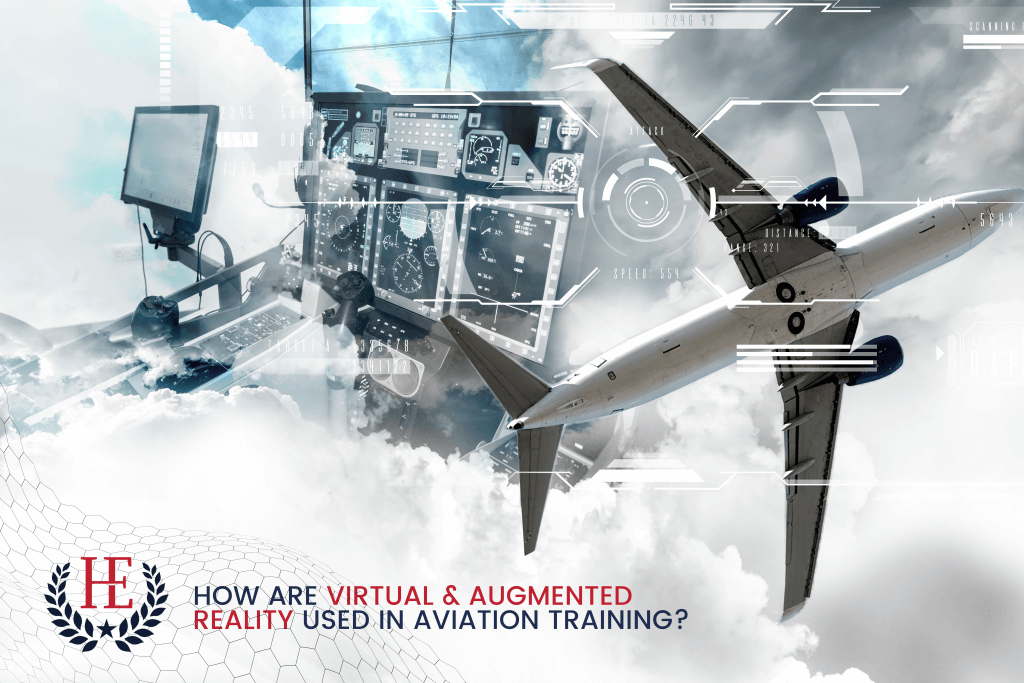
Contributors: Rachel Bryars and Andrea Pressnell
Graphic Design: Nicole Szews
Virtual and augmented reality training allows users to practice skills in a safer and more cost-effective environment than in the real world. Many industries, including aviation, are tapping into these innovative experiences to achieve real-world training results at a fraction of the usual cost, time, and complexity — a significant solution in high-demand industries in which training efficiency is paramount.
Virtual and augmented reality allows crews to practice their skills, simulate different scenarios, and learn new information in highly realistic environments that allow trainees to get in more frequent practice than they may in a real-world environment that can be limited by logistics.
Training Effectiveness
The technology is rapidly catching on as training effectiveness metrics provide examples of how extended reality solutions are effectively leveraged. For example, Embry Riddle Aeronautical University reduced the length of time before a student could fly “solo” by a whopping 30% by integrating VR into its private pilot training curriculum, according to AINonline.
“In a recent study, VR emerged as an amazingly effective learning modality, beating out traditional classroom instruction and e-learning by a wide margin,” reports Stuart “Kipp” Lau.
“Consulting firm Price Waterhouse Cooper released a study in June 2021 that showed VR learners mastered content four times faster than in a classroom setting, were 275 percent more confident to apply skills learned after training, and were more emotionally connected and focused than classroom or e-learners.”
Virtual versus Augmented Reality
Both AR and VR are becoming increasingly popular in aviation training, but what is the difference between the two technologies? Virtual reality (VR) technology immerses users in a completely virtual, three-dimensional world. You usually need a headset device to access and take part in a VR world.
On the other hand, augmented reality (AR) technology superimposes graphics onto real-world surroundings. Typical hardware for AR applications is a mobile device or a head mounted display.
Training Applications of AR and VR in the Aviation Industry
Pilots, cabin crew members, and flight deck employees alike can use AR and VR training to prepare themselves for different situations and learn about their aircraft. For example, flight crews can use AR and VR to simulate and practice emergency evacuations. Pilots can use these training experiences to practice using aircraft controls.
There are several use cases for AR and VR in aviation training, such as the following:
- Flight Deck Training: The pilots and the flight engineer work in the cockpit of the aircraft. These individuals need to know how to react in an emergency situation and communicate efficiently with the rest of the crew. Using VR and AR, they can practice these scenarios in a safe, virtual environment.
- Maintenance Activities: Regular maintenance by aviation engineers is necessary to ensure a safe flight. However, it can be difficult for engineers to access the equipment that they need to practice their skills. Using VR and AR, they can interact with complex aircraft parts and simulate repairs so they can learn how to properly maintain various planes. Beyond training, AR is becoming more commonly used during actual maintenance activities, to guide and improve outcomes.
- Pre-Flight Inspections: There are many people involved in ensuring a safe flight, from the ground crew to flight attendance. These individuals undergo a series of strict protocols prior to takeoff to ensure flight safety. VR and AR enables these teams to frequently practice the inspection with or without an actual aircraft to improve efficiencies.
- Pilot Vehicle Interfaces: As flight software and hardware evolve, it is important to update the user experience for the pilot and crew. Rapid iteration on next-gen, conceptual design and user interface improvements will enhance situational awareness and ease of use for onboard systems. Using tools like Unreal Engine, our team has integrated live telemetry and GIS data to create high-fidelity flight scenarios for simulation or pilot training.
The Benefits of AR and VR for Aviation Training
AR and VR can deliver multiple benefits for aviation training. These environments are not only safer than real-world scenarios, but they are also more accessible. It is more efficient and less expensive to set up a virtual training program versus procuring aviation equipment for employee practice. Students can move through programs faster, with better skill retention and mastery outcomes. Through frequent practice in highly realistic environments, cost, time to train, and logistical complexity is reduced while the potential for training frequency is increased.
Interested in Virtual & Augmented Reality Training? Contact HigherEchelon
Virtual and augmented reality can offer powerful training opportunities for many industries, not just aviation. Professional athletes, astronauts, government agencies, and more are using these technologies to train faster and smarter.
If you are interested in implementing advanced training experiences that leverage AR and VR, the experts at HigherEchelon can help. Our specialists are skilled in developing enhanced, immersive experiences to support training across industries.
Contact us today to learn more about what we can do for you. Call us at 256-724-8843, email us at solutions@higherechelon.com, or fill out this form to schedule a free consultation.